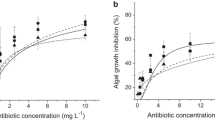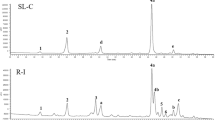Abstract
Proton-pump inhibitors (PPIs) are among the most commonly used over-the-counter drugs, although they have a number of adverse effects. Therefore, long-term use of PPIs may cause toxic effects on host cells and organs. This study evaluated the toxicity of five commonly used PPIs, namely esomeprazole (EPZ), lansoprazole (LPZ), omeprazole (OPZ), pantoprazole (PPZ), and rabeprazole sodium (RPZ-Na), on three plant-based eukaryotic test models (Allium cepa L., Allium sativum L., and Cicer arietinum L.). The PPIs were tested at 100 µg/mL on A. cepa and A. sativum at 24, 48, and 72 h, and on C. arietinum at 72 h of exposure time. Copper sulfate at 0.6 µg/mL was used as a positive control. Root growth profile was considered in the cases of A. cepa and A. sativum, while both shoot and root growth profiles were considered for C. arietinum. All the PPIs showed significant (p < 0.05) toxic effects as they reduced the number of roots and length of roots and shoots in the three test systems in comparison to the negative control group. PPZ exerted higher toxic effects on all the test systems than the other PPIs. All the PPIs exerted more toxic effects at 72 h than at 48 h of exposure time on A. cepa and A. sativum. In conclusion, PPIs exerted toxic effects on the root and/or shoot of A. cepa, A. sativum, and C. arietinum in a time-dependent manner. In this study, the results obtained with the A. sativum and C. arietinum tests were similar to those obtained with the A. cepa, suggesting that these less widely used tests may be useful as a complement to the traditional Allium test.



Similar content being viewed by others
References
Hálfdánarson ÓÖ, Pottegård A, Björnsson ES, Lund SH, Ogmundsdottir MH, Steingrímsson E, Ogmundsdottir HM, Zoega H (2018) Proton-pump inhibitors among adults: a nationwide drug-utilization study. Therap Adv Gastroenterol 11:1756284818777943. https://doi.org/10.1177/1756284818777943
Scheiman JM (2013) The use of proton pump inhibitors in treating and preventing NSAID-induced mucosal damage. Arthr Res Ther 15(Suppl 3):S5. https://doi.org/10.1186/ar4177
McCarthy DM (2010) Adverse effects of proton pump inhibitor drugs: clues and conclusions. Curr Opin Gastroenterol 26(6):624–631. https://doi.org/10.1097/MOG.0b013e32833ea9d9
Rossi S (2006) Australian medicines handbook. Sydney. https://www.scirp.org/(S(i43dyn45teexjx455qlt3d2q))/reference/ReferencesPapers.aspx?ReferenceID=59446
Clark DW, Strandell J (2006) Myopathy including polymyositis: a likely class adverse effect of proton pump inhibitors? Eur J Clin Pharmacol 62(6):473–479. https://doi.org/10.1007/s00228-006-0131-1
De Bruyne P, Ito S (2018) Toxicity of long-term use of proton pump inhibitors in children. Arch Dis Childhood 103(1):78–82. https://doi.org/10.1136/archdischild-2017-314026
Kar S, Roy K, Leszczynski J (2018) Impact of pharmaceuticals on the environment: risk assessment using QSAR modeling approach. In: Nicolotti O (ed) Computational toxicology: methods and protocols. Springer, New York, pp 395–443. https://doi.org/10.1007/978-1-4939-7899-1_19
Paz MFCJ, de Alencar MVOB, de Lima RMP, Sobral ALP, do Nascimento GTM, Dos Reis CA, Coêlho MPSS, do Nascimento MLLB, Gomes Júnior AL, Machado KC (2020) Pharmacological effects and toxicogenetic impacts of omeprazole: genomic instability and cancer. Oxidat Med Cellul Longev. https://doi.org/10.1155/2020/3457890
Leme DM, Marin-Morales MA (2009) Allium cepa test in environmental monitoring: a review on its application. Mutat Res 682(1):71–81. https://doi.org/10.1016/j.mrrev.2009.06.002
Sharifi-Rad J, Mnayer D, Tabanelli G, Stojanović-Radić Z, Sharifi-Rad M, Yousaf Z, Vallone L, Setzer W, Iriti M (2016) Plants of the genus Allium as antibacterial agents: from tradition to pharmacy. Cell Molecul Biol 62(9):57–68
Salehi B, Zucca P, Orhan IE, Azzini E, Adetunji CO, Mohammed SA, Banerjee SK, Sharopov F, Rigano D, Sharifi-Rad J (2019) Allicin and health: a comprehensive review. Trends Food Sci Technol 86:502–516. https://doi.org/10.1016/j.tifs.2019.03.003
Cabuga CC Jr (2017) Allium cepa test: An evaluation of genotoxicity. Proc Int Acad Ecol Environ Sci 7(1):12–19
Levan A (1938) The effect of colchicine on root mitoses in Allium. Hereditas 24(4):471–486. https://doi.org/10.1111/j.1601-5223.1938.tb03221.x
Fiskesjö G (1985) The Allium test as a standard in environmental monitoring. Hereditas 102(1):99–112. https://doi.org/10.1111/j.1601-5223.1985.tb00471.x
Abedin MJ, Cotter-Howells J, Meharg AA (2002) Arsenic uptake and accumulation in rice (Oryza sativa L.) irrigated with contaminated water. Plant Soil 240(2):311–319. https://doi.org/10.1023/A:1015792723288
Abedin MJ, Meharg AA (2002) Relative toxicity of arsenite and arsenate on germination and early seedling growth of rice (Oryza sativa L.). Plant Soil 243(1):57–66. https://doi.org/10.1023/A:1019918100451
Rahman M (2004) Influence of soil arsenic concentrations on rice (Oryza sativa L.). J Subtrop Agric Res Dev 2(3):24–31
Marin A, Pezeshki S, Masschelen P, Choi H (1993) Effect of dimethylarsenic acid (DMAA) on growth, tissue arsenic, and photosynthesis of rice plants. J Plant Nutr 16(5):865–880. https://doi.org/10.1080/01904169309364580
Bhattacharya S, De Sarkar N, Banerjee P, Banerjee S, Mukherjee S, Chattopadhyay D, Mukhopadhyay A (2012) Effects of arsenic toxicity on germination, seedling growth and peroxidase activity in Cicer arietinum. Int J Agric Food Sci 2:131–137
Konuk M, Liman R, Cigerci IH (2007) Determination of genotoxic effect of boron on Allium cepa root meristematic cells. Pak J Bot 39(1):73–79
da Mata AMPF, Paz MFCJ, de Menezes A-APM, dos Reis AC, Souza BS, Sousa CDC, Machado SA, Medeiros TSG, Sarkar C, Islam MT, Sharifi-Rad J, Daştan SD, Alshehri MMM, e Sousa JMC, Melo Cavalcante AAC (2022) Evaluation of mutagenesis, necrosis and apoptosis induced by omeprazole in stomach cells of patients with gastritis. Cancer Cell Int. https://doi.org/10.1186/s12935-022-02563-5
Adeyemo OA, Farinmade AE (2013) Genotoxic and cytotoxic effects of food flavor enhancer, monosodium glutamate (MSG) using Allium cepa assay. Afr J Biotechnol 12(13):1459–1466. https://doi.org/10.4314/AJB.V12I13
Qin R, Wang C, Chen D, Björn LO, Li S (2015) Copper-induced root growth inhibition of Allium cepa var. agrogarum L. involves disturbances in cell division and DNA damage. Environ Toxicol Chem 34(5):1045–1055. https://doi.org/10.1002/etc.2884
Fusconi A, Repetto O, Bona E, Massa N, Gallo C, Dumas-Gaudot E, Berta G (2006) Effects of cadmium on meristem activity and nucleus ploidy in roots of Pisum sativum L. cv. Frisson seedlings. Environ Exp Bot 58(1–3):253–260. https://doi.org/10.1016/j.envexpbot.2005.09.008
Webster P, MacLeod R (1996) The root apical meristems and its margins. In: Waisel Y, Eshel A, Kafkafi U (eds) Plant roots: the hidden half. Marcel Dekker Inc, New York, pp 51–76
Seth CS, Chaturvedi PK, Misra V (2007) Toxic effect of arsenate and cadmium alone and in combination on giant duckweed (Spirodela polyrrhiza L.) in response to its accumulation. Environ Toxicol 22(6):539–549. https://doi.org/10.1002/tox.20292
Ogilvie BW, Yerino P, Kazmi F, Buckley DB, Rostami-Hodjegan A, Paris BL, Toren P, Parkinson A (2011) The proton pump inhibitor, omeprazole, but not lansoprazole or pantoprazole, is a metabolism-dependent inhibitor of CYP2C19: implications for coadministration with clopidogrel. Drug Metabol Dispossit 39(11):2020–2033. https://doi.org/10.1124/dmd.111.041293
Braga AL, de Meneses A-APM, Santos JVdO, dos Reis AC, de Lima RMT, da Mata AMOF, Paz MFCJ, Alves LBdS, Shaw S, Uddin SJ, Rouf R, Das AK, Dev S, Shil MC, Shilpi JA, Khan IN, Islam MT, Ali ES, Mubarak MS, Mishra SK, e Sousa JM, Melo-Cavalcante AAC (2018) Toxicogenetic study of omeprazole and the modulatory effects of retinol palmitate and ascorbic acid on Allium cepa. Chemosphere 204:220–226. https://doi.org/10.1016/j.chemosphere.2018.04.021
Wang C, Wang J, Wang X, Xia Y, Chen C, Shen Z, Chen Y (2017) Proteomic analysis on roots of Oenothera glazioviana under copper-stress conditions. Sci Rep 7(1):1–12. https://doi.org/10.1038/s41598-017-10370-6
MuraliAchary VM, Panda BB (2010) Aluminium-induced DNA damage and adaptive response to genotoxic stress in plant cells are mediated through reactive oxygen intermediates. Mutagenesis 25(2):201–209. https://doi.org/10.1093/mutage/gep063
Acknowledgements
We are owed to master Abdullah Mohammed for his help during conduction of this study.
Author information
Authors and Affiliations
Corresponding author
Ethics declarations
Conflict of interest
The authors declare that they have no conflict of interest.
Additional information
Publisher's Note
Springer Nature remains neutral with regard to jurisdictional claims in published maps and institutional affiliations.
Significance Statement: Plants and their products, such as seeds, when exposed to toxicants at high concentrations or through repeated exposure, show toxicity manifestations, such as a decrease in total height, seed germination delay, downturn tillering, poor shoot and root growth, a decrease in fruit and grain output, tissue damage, and death. Allium cepa (bulb), Allium sativum (clove), and Cicer arietinum (seeds), widely cultivated in Bengal, are the major food and spice sources in this region. This study will be able to introduce a new plant-based protocol and provide supportive information for future preclinical and clinical studies on these frequently used PPIs and their toxicogenetic effects on higher eukaryotic models. Future efforts are needed to better understand the toxicity mechanisms involved in long-term PPI administration.
Rights and permissions
Springer Nature or its licensor (e.g. a society or other partner) holds exclusive rights to this article under a publishing agreement with the author(s) or other rightsholder(s); author self-archiving of the accepted manuscript version of this article is solely governed by the terms of such publishing agreement and applicable law.
About this article
Cite this article
Islam, M.T., Iriti, M., Martorell, M. et al. Phytotoxicity Evaluation of Five Proton-Pump Inhibitors Through Plant-Based Eukaryotic Test Models. Proc. Natl. Acad. Sci., India, Sect. B Biol. Sci. 94, 93–100 (2024). https://doi.org/10.1007/s40011-023-01508-w
Received:
Revised:
Accepted:
Published:
Issue Date:
DOI: https://doi.org/10.1007/s40011-023-01508-w




